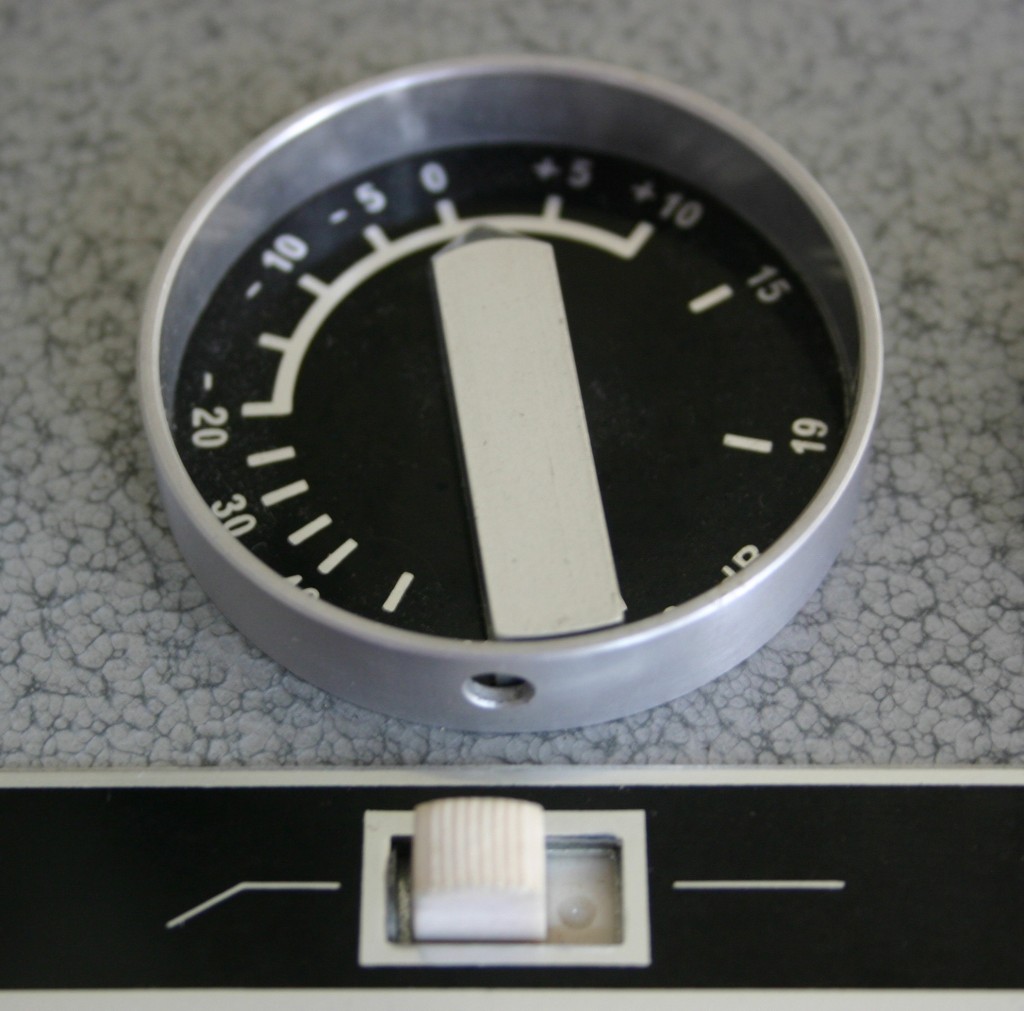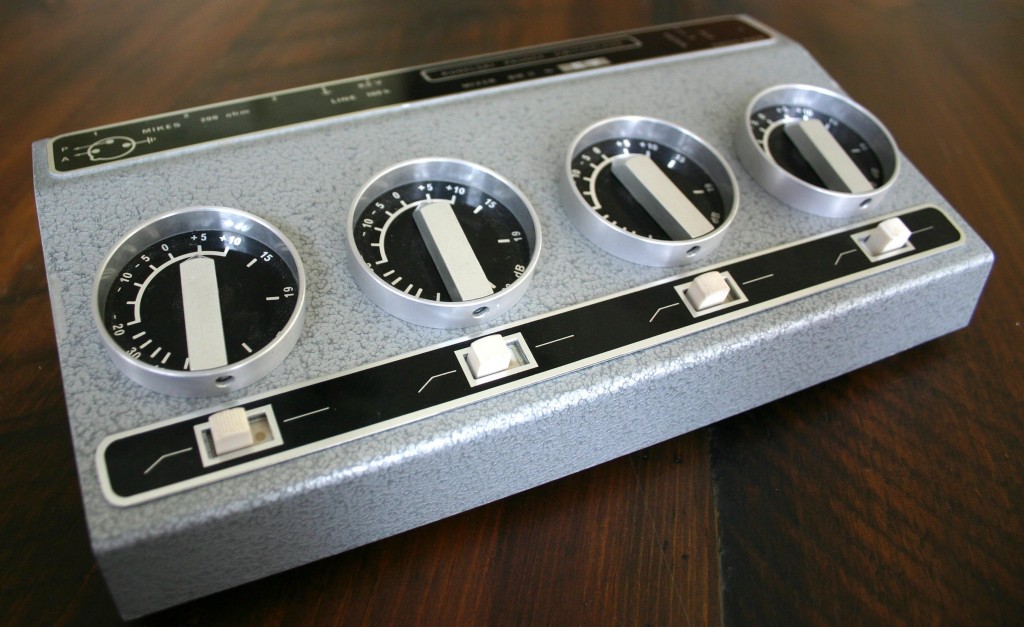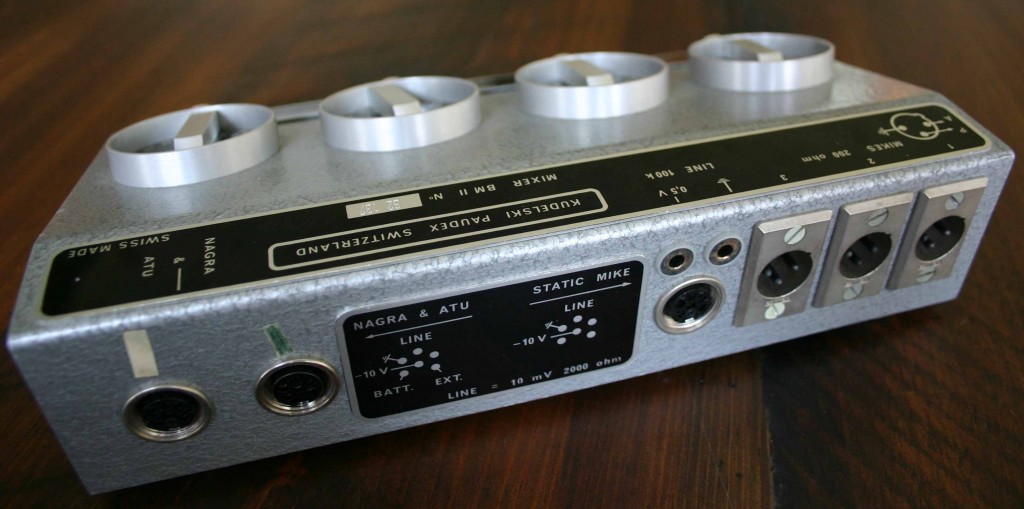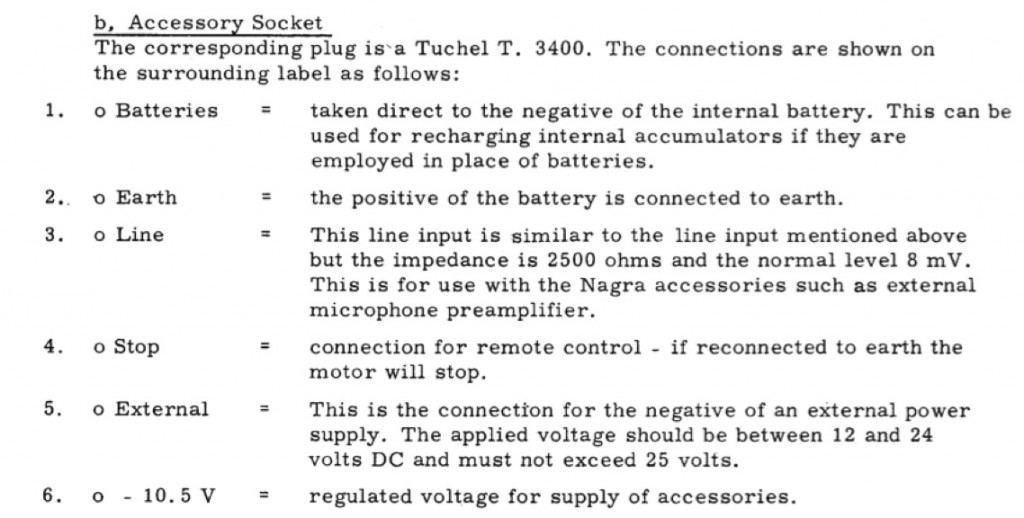 I’ve always coveted these little Nagra BMII audio mixers and but I somehow resisted the urge to purchase one on eBay. It is a 4 channel mono mixer with simple level and low cut controls. They come up regularly for around $200 since a fair number were sold (and none were likely disposed of, due to their great cost-when-new). One factor in my hesitance was that *no one is ever willing to confirm that they do in fact work, and/or *no one seems to be able to confirm how to interface them with standard pro audio equipment, and/or *no one seems to be able to confirm what the operational specs are – gain, impedance, i/o format, frequency response. The BMII was designed and built solely for use with the Nagra recorder, the most expensive, most finely crafted portable analog tape recorder ever built, and the Nagra has somewhat peculiar i/o and power requirements.
I’ve always coveted these little Nagra BMII audio mixers and but I somehow resisted the urge to purchase one on eBay. It is a 4 channel mono mixer with simple level and low cut controls. They come up regularly for around $200 since a fair number were sold (and none were likely disposed of, due to their great cost-when-new). One factor in my hesitance was that *no one is ever willing to confirm that they do in fact work, and/or *no one seems to be able to confirm how to interface them with standard pro audio equipment, and/or *no one seems to be able to confirm what the operational specs are – gain, impedance, i/o format, frequency response. The BMII was designed and built solely for use with the Nagra recorder, the most expensive, most finely crafted portable analog tape recorder ever built, and the Nagra has somewhat peculiar i/o and power requirements.
 NEways… picked one up at the flea market this weekend for a few dollars; it did not come with a power supply but it did have a couple of the necessary Tuchel 6-pin cables, which will save me the trouble of hacking new jacks into the back of the unit.
NEways… picked one up at the flea market this weekend for a few dollars; it did not come with a power supply but it did have a couple of the necessary Tuchel 6-pin cables, which will save me the trouble of hacking new jacks into the back of the unit.

 The Tuchel connector was a popular audio-connector format for professional gear in Germany in the 60s and 70s; I have some obscure old Sennheisier mics that use these things. Anyhow, a quick search online revealed a Nagra recorder manual that confirmed the pinout data on the rear of the mixer:
The Tuchel connector was a popular audio-connector format for professional gear in Germany in the 60s and 70s; I have some obscure old Sennheisier mics that use these things. Anyhow, a quick search online revealed a Nagra recorder manual that confirmed the pinout data on the rear of the mixer:
 A few things to note: pin two does NOT connect to earth, chassis, or anything else, in the BMII: it only ‘loops thru’ to the other pin 2. Ground connection is actually achieved only thru the Tuchel shell itself. The output of the BMII is unbalanced, 2K ohm; this is suitable for connection to consumer ‘RCA’ type inputs. The inputs of the BMII are 200 ohm, and they seem to be balanced, but since I can’t find a schematic for the unit and there are no input transformers in the unit I can’t be sure. The entire thing is built on turret boards and the wiring is good… not the best I have ever seen, but very good. One thing that makes me a little nervous is that all the electrolytics (and there are dozens of them) are they particular translucent-blue brand (anyone?) that always seem to be the faulty component in whatever piece of 60’s pro audio gear I happen to be servicing at the moment.
A few things to note: pin two does NOT connect to earth, chassis, or anything else, in the BMII: it only ‘loops thru’ to the other pin 2. Ground connection is actually achieved only thru the Tuchel shell itself. The output of the BMII is unbalanced, 2K ohm; this is suitable for connection to consumer ‘RCA’ type inputs. The inputs of the BMII are 200 ohm, and they seem to be balanced, but since I can’t find a schematic for the unit and there are no input transformers in the unit I can’t be sure. The entire thing is built on turret boards and the wiring is good… not the best I have ever seen, but very good. One thing that makes me a little nervous is that all the electrolytics (and there are dozens of them) are they particular translucent-blue brand (anyone?) that always seem to be the faulty component in whatever piece of 60’s pro audio gear I happen to be servicing at the moment.
Alright so… I’m going to build a little power supply for this thing and fire it up, see what happens. If it does in fact work + sound great, I am thinking I can add a 2K:600 UTC output transformer to make the thing useful for modern interfacing. Since the BMII was designed for ultra-critical location recording of major film productions, I am hoping to be impressed with the sound… soon…
10 replies on “Swiss Mix”
Hiya
Just wondering how this sounds? Does it run off batteries as well as mains?
Would it be worth using with a digital recorder?
Thank you
I have not been able to get it working yet… made a power supply and nothing doin. which is why I hadn’t posted a follow-up… if i ever do get it runnin, y’all will hear ’bout it…
ok. thanks.
Can I just ask, does this take batteries?
I have one of those. They are ok sounding. Just ok. Discrete germanium amp stages, hence the -10/0v power supply connection on the out jack. It fed from the Nagra unit. Make sure you are feeding it -10v to the proper pin, and try recapping the electrolytics. They are all shot, I’m sure. Not sure what the hype is over germanium technology. It sounds kind of abrasive and inconsistent, and eventually start to leak and cause ridiculous problems with feedback loops, etc. I would bet that all of the old Monty Python location recordings (Life of Brian, Holy Grail) had these rigs. Whether the original recordings were ADR or not I have no idea.
Thanks Keith. Yes I tried to run mine, and I got nada. Nothing. No sound whatsoever. I am certain I was supplying the power correctly. I have found that those 1960’s blue electrolytics tend to fail. but my lord so many to replace! Service data with test voltage points would speed up servicing. Any idea where I can find this? c.
The translucent blue electrolytics are from BC components, now owned by Vishay. They still make them with the same shell, and in some of the oddball capacitance values and voltages. (For example 400uF rather than the more common 470uF.)
hi, you need
3 wires from bm11 to nagra 111
2/=earth and one plug case= positive +12volts (nagra battery earth)
3/=line out to nagra line in via ”line input” pot on nagra
6/= – 10.5 volts supply for auxilliaries from nagra to the bm11
THAT IS ALL!!!!!
============
To test if any electrolytics have ”gone”
no power and test with ommeter on lowest range
should pulse either way round on momentary connection(look at connections on electrolytivc AND ohmmeter at same time!)
OTHERWISE
Should be 9 to 11 volts across each
if zero on a little voltage then
Change the electrolytic !
good luck
Alvin
Hey guys,
I have the schematic of the BM2 here.
Give me a shout if you need it.
Cheers
Michael
I am curious about the sound of this mixer, have you tried it ?
Also curious to have a look at the schematics as I might be on the hunt for one, to make some minimal location recordings with my Nagra III
Cheers & thanks
Thomas (France)